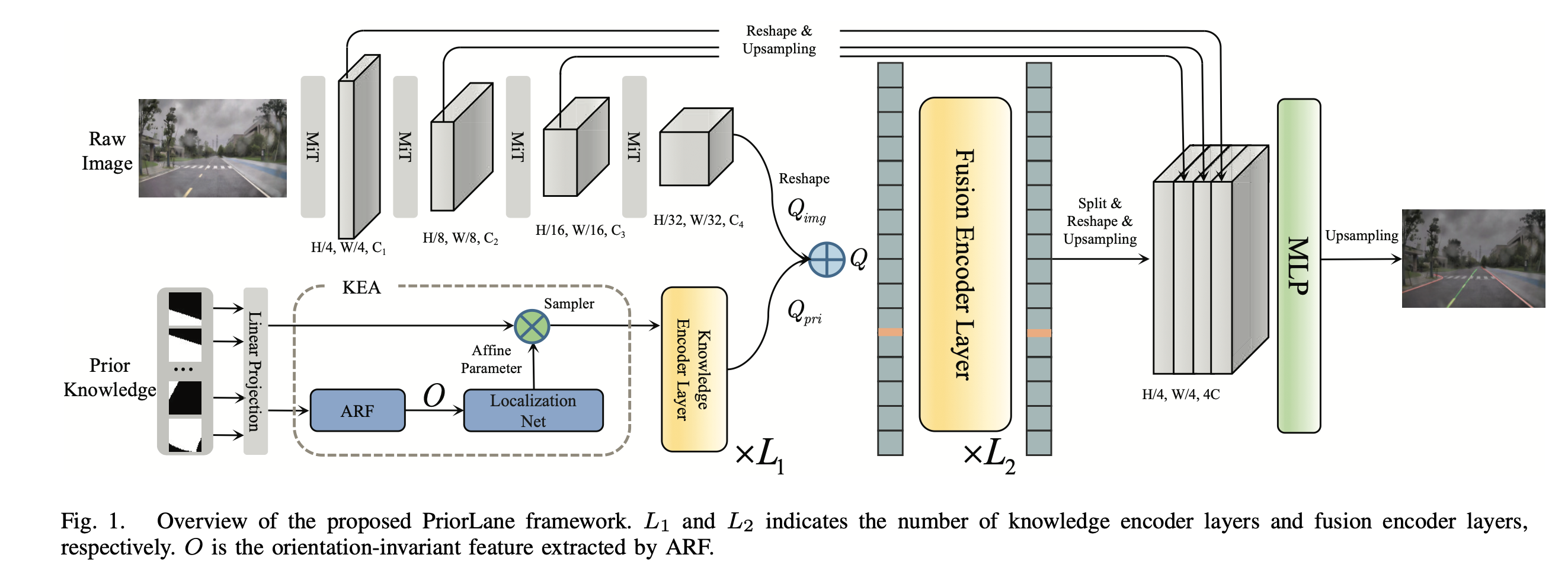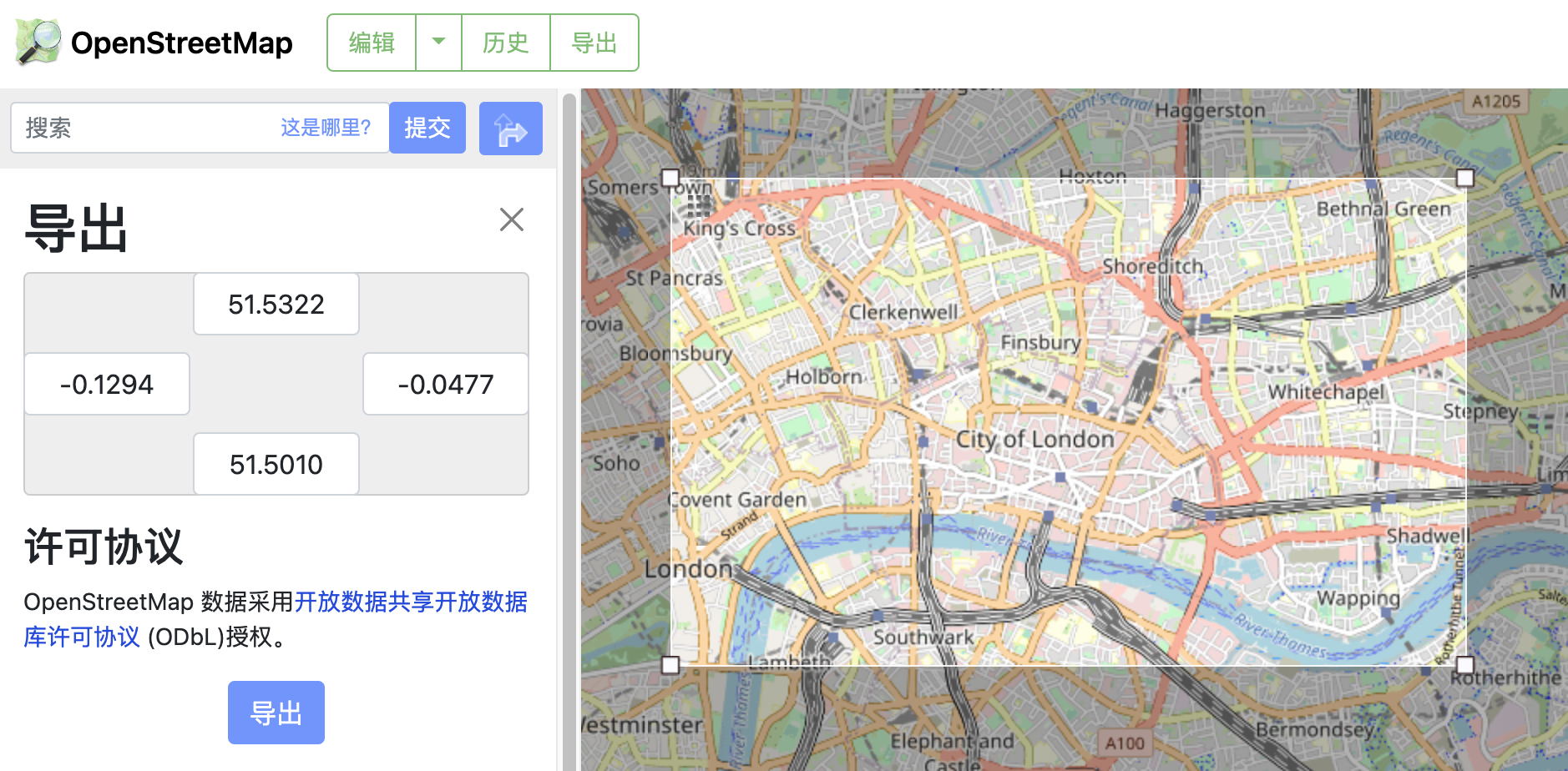This repository is the official Pytorch implementation of our paper PriorLane: A Prior Knowledge Enhanced Lane Detection Approach Based on Transformer (ICRA 2023).
PriorLane is a novel and general framework, which is proposed to fuse the image feature with the prior knowledge to enchance the performance of lane segmentation. The prior knowledge used in our experiments is extracted from the open source Open Street Map data, which is low-cost.
If you don't have prior knowledge in your dataset, we employed an intuitive extension of segformer by adding a bench for lane marking existence prediction, which is called MiT-Lane in our experiments. The whole model could be pre-trained on ImageNet dataset, and fine-tuned for lane segmentation, since the transformer-only architecture used in lane detection and general segmentation are unified in an elegant way.
We use SegFormer as the codebase, which is on MMSegmentation. For lane detection without prior knowledge, here is an example (CUDA 11.4):
conda create --name priorlane python=3.7
conda activate priorlane
conda install pytorch=1.9.1 torchvision cudatoolkit
conda install pillow=6.1
pip install IPython
pip install matplotlib
pip install mmsegmentation
pip install timm==0.3.2
pip install mmcv-full==1.2.7
pip install opencv-python==4.5.1.48
cd Priorlane && pip install -e . --user
For lane detection with prior knowledge, Active Rotation Filter implemented by ORN needs to be installed:
cd mmseg/models/orn
pip install .
For TuSimple, prepare the data like this:
├── tusimple
│ ├── clips
│ │ ├── dir1
│ │ │ ├── fold1
│ │ │ │ ├── ***.jpg
│ ├── seg_label
│ │ ├── dir1
│ │ │ ├── fold1
│ │ │ │ ├── ***.png
│ ├── list
│ │ ├── train_gt.txt
│ │ ├── val_gt.txt
│ │ ├── test_gt.txt
For CULane, prepare the data like this:
├── culane
│ ├── dir1
│ │ ├── **.mp4
│ │ │ ├── ***.jpg
│ │ │ ├── ***.lines.txt
│ ├── laneseg_label_w16
│ │ ├── dir1
│ │ │ ├── **.mp4
│ │ │ │ ├── ***.png
│ │ │ │ ├── ***.lines.txt
│ ├── list
│ │ ├── train_gt.txt
│ │ ├── val_gt.txt
│ │ ├── test_gt.txt
The Zjlab dataset is not allowed open source according to laboratory policy. Prepare your own lane detection dataset with prior knowledge as follows:
├── Custom data with prior knowledge
│ ├── imgs
│ │ ├── **.jpg
│ ├── seg
│ │ ├── **.png
│ ├── prior (local prior knowledge rendered into a image)
│ │ ├── **.png
│ ├── list
│ │ ├── train.txt(an img id per row)
│ │ ├── val.txt
│ │ ├── test.txt
We use an image with multi-channels to represent the local prior knowledge, and the prior knowledge used in our experiments is generated from the OSM data.
Step 1: Export global prior knowledge from OSM web.
Step 2: Use osm2geojson to convert the data into geojson format.
Step 3: Use python-opencv to render geometries with different propertes in the geojson file, and the global prior knowledge is represented as a big image.
Step 4: Crop local prior knowledge from the global image, here is an example:
global_img = cv2.imread(path_to_global_image)
def get_local_prior(range=100):
utmx, utmy = get_current_utm_pose()
# 5 pixels == 1 meter
# (startx, starty): utm value of the top-left point of global image.
px, py = math.ceil((utmx-startx)*5), math.ceil(abs(utmy-starty)*5)
point = [px, py]
x1, x2, y1, y2 = point[0]-range, point[0]+range, point[1]-range, point[1]+range
crop_x1 = max(0, x1)
crop_y1 = max(0, y1)
crop_x2 = min(global_img.shape[1], x2)
crop_y2 = min(global_img.shape[0], y2)
mtx = global_img[crop_y1:crop_y2, crop_x1:crop_x2]
left_x = -x1
top_y = -y1
right_x = x2 - global_img.shape[1]
down_y = y2 - global_img.shape[0]
if (top_y > 0 or down_y > 0 or left_x > 0 or right_x > 0): # Out of the boundary.
left_x = left_x if left_x> 0 else 0
right_x = right_x if right_x> 0 else 0
top_y = top_y if top_y> 0 else 0
down_y = down_y if down_y> 0 else 0
dest_mtx = cv2.copyMakeBorder(mtx, top_y, down_y, left_x, right_x, cv2.BORDER_CONSTANT, value=(0,0,0))
else:
dest_mtx = mtx
# Rotate the local img
rows, cols, chs = dest_mtx.shape
img_circle = np.zeros((rows,cols,1),np.uint8)
img_circle = cv2.circle(img_circle,(int(cols/2),int(rows/2)),int(min(rows, cols)/2),(1),-1)
local_map = dest_mtx[:,:,0]*img_circle[:,:,0]
local_map = np.array([local_map]*3)
local_map = np.ascontiguousarray(local_map.transpose((1,2,0)))
(h, w) = local_map.shape[:2]
(cX, cY) = (w // 2, h // 2)
M = cv2.getRotationMatrix2D((cX, cY), random.randint(0,360), 1.0)
rotated = cv2.warpAffine(local_map, M, (w, h))
rotated[rotated[:,:,0]>0] = (1,1,1)
return rotated
Download mit_b5 weights pretrained on ImageNet-1K, and put it in the folder pretrained/.
Example: train PriorLane on your custom dataset with prior knowledge:
bash tools/dist_train_lane_detection_with_prior.sh
Please refer to local_configs/priorlane for corresponding configurations, you can also modify the configurations according to the custom dataset, and the trained results will be saved in work_dirs.
Example: train MiT-Lane on TuSimple & CULane
bash tools/dist_train_tusimple.sh
or
bash tools/dist_train_culane.sh
Evaluate on TuSimple using official metric:
python tools/test_tusimple_metric.py ./local_configs/priorlane/tusimple.py ./work_dirs/tusimple/mit_tusimple.pth
Produce the pred.json file under tusimple_data_root, and use tools/lane_evaluation/tusimple/lane.py for metric calculation.
Evaluate on CULane using official metric:
python tools/test_culane_metric.py ./local_configs/priorlane/culane.py ./work_dirs/culane/mit_culane.pth
Produce coord_output dir under culane_data_root, run bash tools/lane_evaluation/CULane/Run.sh to calculate the F1-measure. For evaluation tool install, please refer to
SCNN.
The code is for research purpose only, for detail, please check the LICENSE file in the repositores referenced by our code.
- SegFormer for MiT and decode head implementation.
- FP-DETR for fusion transformer design.
- ORN for ARF and ORPooling implementation.
- SCNN for TuSimple and CULane evaluation.
- osm2geojson for conversion from osm data to geojson format.

